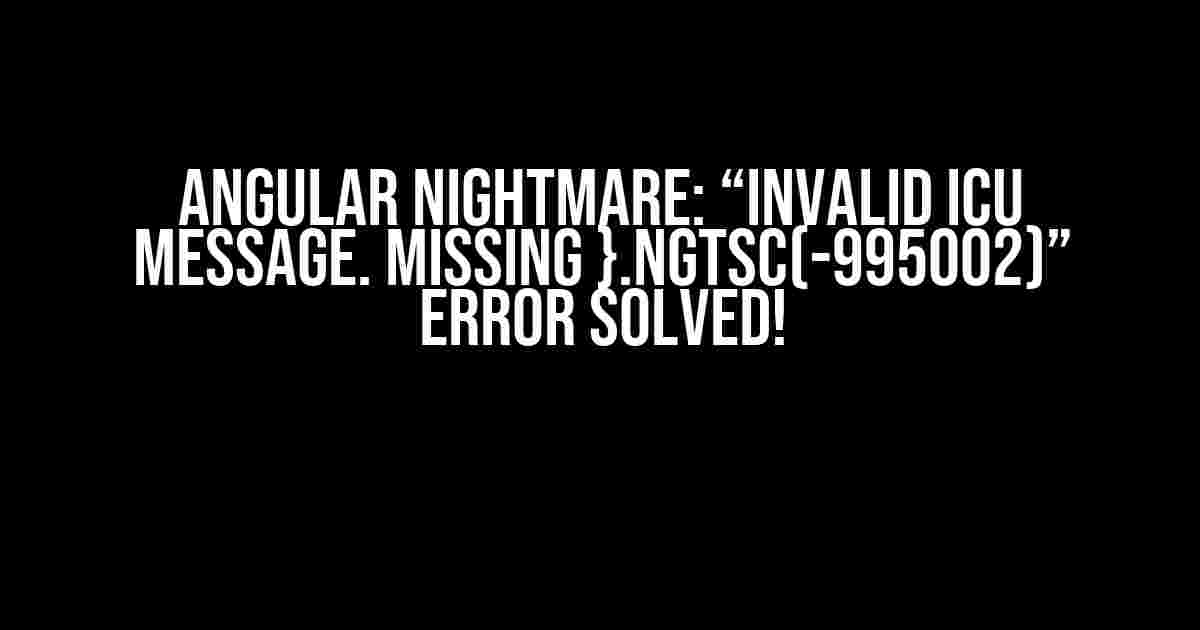Are you tired of staring at the frustrating “Invalid ICU message. Missing }.ngtsc(-995002)” error in your Angular project? Well, put on your detective hat, because we’re about to embark on a thrilling adventure to solve this pesky error together!
- What is the “Invalid ICU message. Missing }.ngtsc(-995002)” error?
- Causes of the Error
- Solution 1: Check for Missing Curly Braces
- Solution 2: Verify Message Format Syntax
- Solution 3: Update Angular and Dependencies
- Solution 4: Disable Ivy Compiler
- Solution 5: Check for Conflicting Plugins or Libraries
- Conclusion
- Bonus: ICU Message Best Practices
- FAQs
What is the “Invalid ICU message. Missing }.ngtsc(-995002)” error?
This error typically occurs when Angular’s Ivy compiler tries to parse an ICU (International Components for Unicode) message that’s missing a closing curly brace (}). But don’t worry, it’s not as scary as it sounds. We’ll break it down into manageable chunks and get your project up and running in no time.
Causes of the Error
- Missing or misplaced curly braces in ICU messages
- Incorrect syntax in the message format
- Outdated Angular or dependencies
- Conflicting plugins or libraries
Solution 1: Check for Missing Curly Braces
Let’s start with the most obvious culprit: missing curly braces. Take a closer look at your ICU messages and ensure that every opening curly brace ({) has a corresponding closing curly brace (}).
{ count, plural,
=0 {no items}
one {one item}
other {# items}
}In the example above, the ICU message is correctly formatted with opening and closing curly braces. Double-check your code to ensure that all messages follow this pattern.
Solution 2: Verify Message Format Syntax
Next, let’s examine the syntax of your ICU message format. Make sure you’re using the correct syntax for the specific type of message you’re working with.
Simple Messages
{ msg }Plural Messages
{ count, plural,
=0 {no items}
one {one item}
other {# items}
}Select Messages
{ gender, select,
male {He}
female {She}
other {They}
}Take a closer look at the official Angular documentation for ICU message formats to ensure you’re using the correct syntax.
Solution 3: Update Angular and Dependencies
Outdated Angular or dependencies can sometimes cause issues like the “Invalid ICU message” error. Make sure you’re running the latest versions of Angular and its dependencies.
ng update @angular/core @angular/cliRun the above command in your terminal to update Angular and the CLI. This might resolve any compatibility issues that could be causing the error.
Solution 4: Disable Ivy Compiler
In some cases, the Ivy compiler can be the source of the issue. Disabling it might help resolve the error. However, keep in mind that this is a temporary solution, and you should aim to fix the underlying issue.
"angularCompilerOptions": {
"enableIvy": false
}Add the above configuration to your `tsconfig.json` file to disable the Ivy compiler.
Solution 5: Check for Conflicting Plugins or Libraries
Finally, let’s investigate if any conflicting plugins or libraries might be causing the issue. Try to isolate the problem by disabling or removing suspected plugins or libraries.
For example, if you’re using a third-party library that integrates with Angular, try disabling it or updating it to the latest version.
Conclusion
By following these steps, you should be able to resolve the frustrating “Invalid ICU message. Missing }.ngtsc(-995002)” error in your Angular project. Remember to:
- Check for missing curly braces in ICU messages
- Verify the syntax of your ICU message format
- Update Angular and dependencies
- Disable the Ivy compiler (as a last resort)
- Check for conflicting plugins or libraries
With these solutions, you’ll be well-equipped to tackle this error and get your Angular project back on track. Happy coding!
Bonus: ICU Message Best Practices
To avoid similar issues in the future, here are some best practices for working with ICU messages in Angular:
| Best Practice | Description |
|---|---|
| Use consistent naming conventions | Follow a consistent naming convention for your ICU messages to avoid confusion. |
| Keep messages concise | Keep your ICU messages concise and focused on a single purpose. |
| Use meaningful IDs | Use meaningful IDs for your ICU messages to make them easy to identify and maintain. |
| Test thoroughly |
By following these best practices, you’ll be able to work with ICU messages in Angular with confidence and avoid common pitfalls.
FAQs
Still have questions about the “Invalid ICU message. Missing }.ngtsc(-995002)” error? Here are some frequently asked questions to help you:
Q: What is ngtsc?
A: ngtsc is the Angular TypeScript Compiler. It’s responsible for compiling your Angular code into efficient and optimized JavaScript code.
Q: Can I ignore this error?
A: No, it’s not recommended to ignore this error. The “Invalid ICU message. Missing }.ngtsc(-995002)” error indicates a problem with your code, and ignoring it might lead to unexpected behavior or errors in your application.
Q: How do I debug ICU messages?
A: You can debug ICU messages by using the Angular CLI’s built-in debugging tools or by using a third-party library like the ICU Message Debugger.
With these solutions and best practices, you’ll be well-equipped to tackle the “Invalid ICU message. Missing }.ngtsc(-995002)” error and work with ICU messages in Angular like a pro!
Frequently Asked Question
Got stuck with the “Invalid ICU message. Missing ‘}’.ngtsc(-995002)” error in Angular? Don’t worry, we’ve got you covered!
What does the “Invalid ICU message. Missing ‘}'” error mean?
This error occurs when there’s a syntax issue in your Internationalization (i18n) messages, specifically with the ICU syntax. It’s complaining about a missing closing curly brace ‘}’ in your message. Check your message format to ensure it’s correctly defined.
How do I identify the problematic ICU message?
To find the culprit, review your i18n messages and look for any ICU syntax errors. Check for missing or mismatched curly braces, incorrect pluralization, or errors in the message format. You can also try removing or commenting out messages one by one to isolate the issue.
What are common ICU message syntax errors?
Some frequent errors include: missing or extra curly braces, incorrect use of pluralization, and mismatched or unclosed quotes. Also, ensure you’re using the correct ICU syntax for your language and that your message IDs match between the translation files and your Angular code.
How can I debug ICU message errors in Angular?
To debug, enable the Angular debug mode by setting the `debug` flag to `true` in your `angular.json` file. Then, run the `ng serve` command with the `–i18n-debug` flag. This will provide more detailed error messages and help you pinpoint the issue.
Can I use a linter to catch ICU message errors?
Yes, you can! There are linters available that can help catch ICU syntax errors, such as the `@angular/compiler-cli` linter. You can also use third-party linters like `i18n-lint` to ensure your ICU messages are correct and consistent.
Let’s get that error sorted out and get back to building amazing Angular apps!





